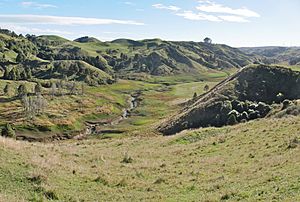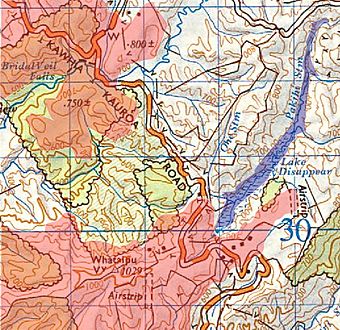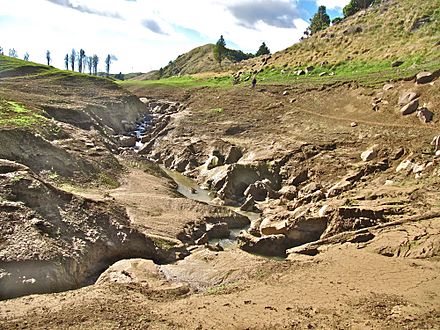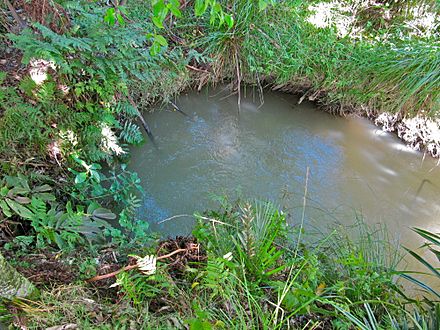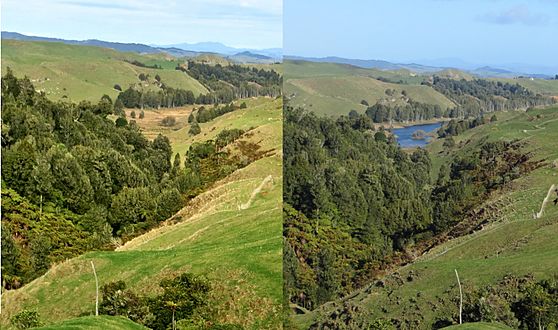Lake Disappear facts for kids
Quick facts for kids Lake Disappear |
|
|---|---|
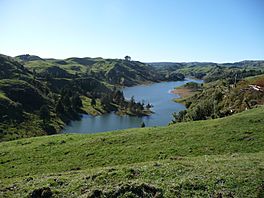
Lake Disappear when full viewed from Kawhia Rd (July 2008)
|
|
| Location | Waikato District, Waikato region, North Island |
| Coordinates | 37°55′34″S 174°55′00″E / 37.926191°S 174.916549°E |
| Lake type | Intermittent |
| Primary inflows | Pakihi Stream |
| Primary outflows | Sinkhole |
| Catchment area | 7 km2 (2.7 sq mi) |
| Basin countries | New Zealand |
| Max. length | 2 km (1.2 mi) |
| Average depth | Up to 15 m (49 ft) |
| Surface elevation | 170 m (560 ft) |
Lake Disappear is a special kind of lake in New Zealand's North Island. It's called an intermittent lake because it often dries up and then fills with water again. Imagine a lake that can vanish! It's also known as a volcanogenic lake, meaning it was formed by volcanic activity.
This unique lake is found about 20 km from Raglan. It's also just 4 km past the beautiful Bridal Veil waterfall. You can see parts of the lake from different roads when it's full. Lake Disappear is the biggest polje in New Zealand. A polje is a large, flat valley in a limestone area that can sometimes fill with water.
Contents
How Lake Disappear Was Formed
Volcanoes, Lava, and Limestone
Lake Disappear sits in a valley that was blocked by a lava flow. This lava came from a volcano called Whataipu about 2 million years ago. The same kind of lava flow also helped create the Bridal Veil waterfall.
Underneath the lava, there's a type of rock called limestone. The lake drains through a hole in this limestone, which is called a sinkhole.
The Disappearing Act
Normally, a stream called Pakihi Stream flows into the area. But during long periods of heavy rain, the water can't drain away fast enough through the sinkhole. When this happens, the water backs up, and a large lake forms over what is usually dry land. This is why it's called Lake Disappear – it comes and goes!
The limestone under the lake is called Elgood Limestone. You can often see this rock in cliffs or on the ground. It's a light grey rock that has many natural channels and holes where water has dissolved it over time.
Life Around the Lake
Plants and Trees
The area around Lake Disappear used to be covered in thick podocarp forests. Today, much of it is used for sheep and beef farms. The Te Uku Wind Farm is also nearby, close to where the Pakihi Stream begins.
When the lake bed is dry, you'll mostly see common pasture plants. But there are also some native sedges (grass-like plants) and a small area of kahikatea forest. Kahikatea are tall native New Zealand trees.
Animals in the Stream
The Pakihi Stream, which feeds the lake, has a variety of aquatic life. Surveys have shown that the stream's health is fair, though sometimes there are large growths of green algae. This can happen when too many nutrients get into the water, often from farms.
Many interesting creatures live in the Pakihi Stream, including:
- Inanga (a type of fish)
- Longfin eels
- Koura (freshwater crayfish)
- Freshwater snails
- Shrimps
- Banded kokopu (another native fish)
Scientists also look for small water insects and other invertebrates to check the stream's health. Some of these include:
- Caddisflies
- Mayflies
- Dobsonflies
- Riffle beetles
- Freshwater mussels
These creatures are like tiny indicators. If they are present and healthy, it means the water quality is good.
Gallery
-
This is the sinkhole where Lake Disappear drains away. The muddy marks show how high the water usually gets.



